Menus
Thirteen by a half dozen !
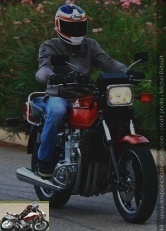 "Gigantic", "pachydermal", "monumental"…. There was no lack of adjectives to qualify the Kawasaki Z 1300 when it was presented at the 1978 Paris Motor Show ….
"Gigantic", "pachydermal", "monumental"…. There was no lack of adjectives to qualify the Kawasaki Z 1300 when it was presented at the 1978 Paris Motor Show ….
Fat state
The 1300 6 was born at a time when manufacturers could afford all the daring. Its motor, inserted into the double-cradle frame, is a thing of the past. Deprived of fins, since cooled by water (specificity which did not formerly benefit from its six-legged cousins Honda 1000 CBX and Benelli 750 SEI), gorged with 120 horsepower and able to train scrap metal and driver at more than 200 km / h, this Kawasaki really made an impression.
Decked out like an ocean liner, it entered the club of exceptional machines straight away. The imperfect is not really in order. Even today, the beautiful adipose is turning a lot of heads. Parked or dynamically, the machine has fascinated for nearly forty years ….
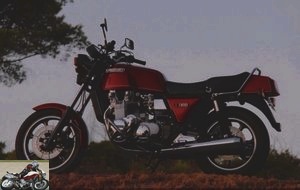
And what health! Brutal or soft depending on the pilot’s desire, its gimbal never faulted, the ideal tool for different riding, with remarkable well-being. And what a pleasure to share such a comfortable saddle, on which the person transported will find a support bar and ideally positioned footrests … So many reasons for wanting to reach the end of the world at his controls. She is capable of it, her reliable mechanics, if maintained with care, will give her tamer the serenity that befits frequent travelers. Admittedly, Madame Plus wriggles a little at high speeds on the highway, scrapes jowls in tight bends of the Departmental and consumes a little oil, but the satisfaction of having between the hocks half a dozen thrilling pistons a motorcycle too beautiful than exceptional, passes off her little flaws for the whims of a real diva…
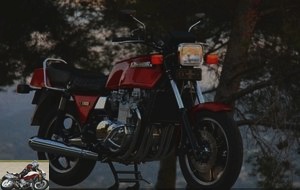
Good piece
Indeed, the 1300 Kawasaki greatly exceeds 300 kilos. But in dynamics, what comfort, smooth and full of torque on top of that. Agile as a giraffe on the ice floe, of course, but yet capable of (a little!), Forgetting its imposing carcass. As for his rising speed, Wolfgang Amadeus could not have done better ….
The model (A 4), presented here, dates from 1982 and has shock absorbers offering a better travel than those of the first vintage, much too weak. In addition, a fork stiffener has been fitted, an extremely welcome accessory during optimistic passages in curves..
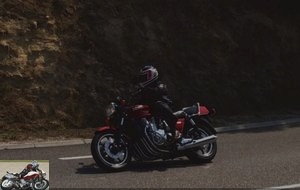
Regarding braking, aviation hoses improve the feeling a little and if the front wheel does not sink into the asphalt once the lever is pressed like a lemon, the fatty callipyge slows down enough to preserve the heart of its pilot, including in emergency cases.
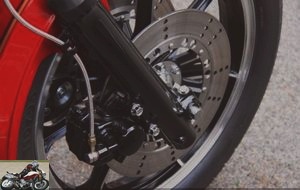
A contactor, allowing the forced start of the fan, ensures good ventilation in all circumstances (essential tip, the engine is often too hot). Finally, a timing chain tensioner taken from a ZZR, preserves any risk of offset. Except for these (important) details, the beauty is entirely original.
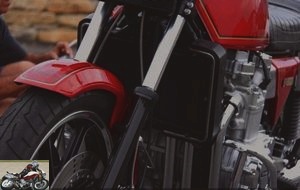
Six-person course
The Z 1300 remains a large road (6 cylinders, cardan shaft), but also wants to be sporty by its aggressive appearance. Technological advances, such as liquid cooling and double-barrel carburettors, immediately appealed to bikers of the late 1970s. During its career, the Z 1300 sold around 2,000 units in France. Finding the opportunity is relatively easy, but beware…
You can find modified, personalized or incomplete Zs from € 4,000, but a total engine overhaul can reach € 3,000 and some parts are very difficult to find and at exorbitant prices. Better to choose a complete, genuine machine with reasonable mileage. Such a motorcycle can fetch € 6,000, while a model such as the one tested here is valued at 10,000 euros.
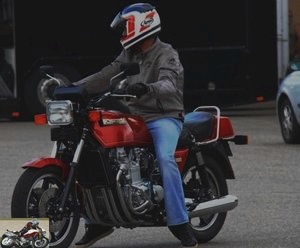
Kawasaki Z engines are known to be reliable, but demand to be treated with care. The timing chain tension should be checked every 10,000 kilometers and its replacement, as well as the tensioner, every 50,000. The oil level should be checked very regularly, consumption is not uncommon. On the chassis side, the play of the steering column should be inspected frequently. On carbureted models, the fuel pump tends to seize.
In addition, handling will be seriously degraded with a "square" rear tire, its replacement will be necessary. These few points respected, the Kawasaki Z 1300 will always be ready to travel the planet in its entirety. At the controls of a machine that in its time collected all the superlatives and still deserves them !
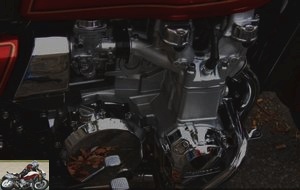
Chronology
1979 : Type A1. Presented at the Paris Motor Show and marketed in early 1979, only in midnight blue colors. Electronic ignition on the right side behind the cylinder block with centrifugal advance. Damper at the left end of the crankshaft. Fork with air pressure on each tube and conventional shock absorbers with adjustment only in spring hardness.
1980 : Type A2. Ruby red and midnight blue colors. Engine oil capacity increased from 4.6L to 5.3L. Shocks are fitted with harder springs and travel is increased by 11mm.
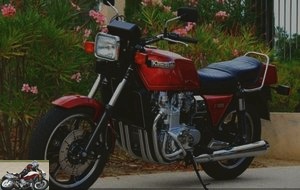
nineteen eighty one : Type A3. Ruby red, green and ebony black colors. The ignition is completely electronic (hall effect) and the igniter passes through the left end of the crankshaft. Engine oil capacity is increased (6.2 L) and a low level switch is added. The crankcases are chrome. A ball mechanism is incorporated in the gearbox to improve the search for neutral. The new AR shocks become adjustable in hydraulic damping. The fork now has only one air pressure valve with a balancing pipe.
1982 : Type A4. Red and black ebony color. The ignition is no longer hall effect but becomes CDI and the igniter is placed on the right side of the crankshaft to make room for the damper on the left side. The clutch, crankcases and bevel gear are modified.
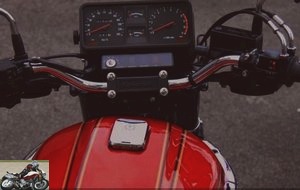
1983 : Type A5. Red and black ebony color. The fork is slightly modified with an increased oil capacity.
1984-1985 : Type ZG1300-A1. Red and black colors. The main development is the replacement of carburettors by injection and modification of the cylinder head, the power goes to 130 hp. The crankcases are further modified to include an oil level check window. The rear shocks are now adjustable in 5 positions with a single inflation valve on the left side. The caster angle is slightly reduced.
1986-1989 (end of worldwide marketing): Type ZG1300-A2. Black color. As a result of the 1985 law, power in France was lowered to 100 horsepower by installing a wedge on the throttle.
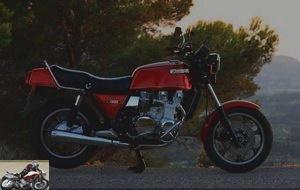
Identification
- Type A1 1979: frame number from KZT30A-000101, engine number from KZT30A-E000101
- Type A2 1980: frame number from KZT30A-006201, engine number from KZT30A-E05801
- Type A3 1981: frame number from KZT30A-011501, engine number from KZT30A-E12401
- Type A4 1982: frame number from KZT30A-014101, engine number from KZT30A-E14801
- Type A5 1983: frame number from KZT30A-015901, engine number from KZT30A-E16401
- Type ZG1300-A1 1984/1985: frame number from ZGT30A-000001
- Type ZG1300-A2 1986 to 1989: frame number from ZGT30A-002801
Strong points
- Six-cylinder power and torque
- Comfort
- Transmission smoothness
- Silent operation
Weak points
- Average braking
- Maneuverability when stationary
- Restoration cost
Kawasaki Z 1300 technical sheet
Thirteen to a half dozen !
Related articles
-
900 new blood ! Praised since its presentation in 1972, the 900 Z1 Kawasaki has now become a legend …. A little history Imagined by Sam Tanegashima, an…
-
Revelation 998 4-cylinder compressor, 998 cm3, 200 hp, 137 Nm of torque, 239 kg, 17,099 euros The Roadster era, a heated era in the motorcycle timeline,…
-
Kawasaki Versys 1000 SE motorcycle test
3rd evolution for the shock road trail hybrid 4 cylinders in line, 1,043 cm3, 120 hp and 102 Nm, KECS electronic suspensions, 257 kg, 16,899 euros…
-
Kawasaki ER-6 N motorcycle test
A very stylish and punchy little urban The city of Mozart sounded for three days of a superb symphony in major exhaust. Orchestrated by Kawasaki making…
-
Closely derived from competition, the Kawasaki KX 250 F and KX 450 F combine innovations and off-road performance. Struggling at the best level, they are…
-
40 horses at 11,500 rpm 25.7 Nm, 175 kilos with full tank, two colors, € 5,799 An easy and sparkling little trail: what if life on a motorcycle was as…
-
Kawasaki Ninja 1000 SX motorcycle test
Compromise without compromise 4 cylinders of 1,043 cm3, 142 hp and 111 Nm, 235 kg, from 14,349 euros In 2010, Kawasaki presented its first Z1000SX, a…
-
2012 Kawasaki ER-6n motorcycle test
New test: Kawasaki ER 6N: Sparkling with mischief ! Appeared in 2006 and restyled in 2009, the ER6 N gets a new facelift that makes it even sexier,…
-
2012 Kawasaki ER-6f motorcycle test
Swiss army knife first price While the ER-6n has been a historic bestseller in the Kawasaki lineup since its debut in 2006, its streamlined “f” version…
-
Evolution or revolution of the ER6-f with the in-line twin of 649 cm3, 68 horsepower for 193 kilos A more sporty look but, paradoxically, a gain in…
No, the loncin engine is of good quality. There have been recalls, but like the Rotax twin of the first F.
It is its operation that is not pleasant. Without elegance in my opinion. Without panache.
I expected more from the 900 cc.
Same: tempted by the 850 GS when it was released, a test quickly dissuaded me … Effective in absolute terms, but flat electroencephalogram in terms of sensations, I thought I was on a Honda !
Obviously this 900 R / XR is in the same vein ….
And yes the 850 GS is platonic, in terms of sensation there are no pictures with the 790 Adventure, and with a little patience the 890 will arrive
Yes SUVs of the bike, I guess the F800GT will stop ?
Otherwise why are some people shouting so much after the Loncin engine? Are there any particular problems (reliability, design, …), apart from these Chinese origins?
No, this engine had recalls on a small first series (1,500 ex) .
Like the Rotax in its early days…
BMW is customary of the fact. Like other European manufacturers.
In short, according to bmw, this engine is designed by him and made in China. Which, objectively, does not (any longer) bode of any poor quality.
On the other hand, this merit is stingy in sensation, lacking in personality, and not very elegant in its sound. Its finish is just as ordinary.
For the rest, they are good motorcycles.
Still, a 900 roadster and an XR lineage had to be more demonstrative.